Wideband Spectrum Sensing Based on Riemannian Distance for Cognitive Radio Networks
Abstract
:1. Introduction
2. System Model and the Proposed Detection Scheme
2.1. System Model
2.2. Riemannian Distance and Riemannian Mean
| Algorithm 1: Iterative Calculation of the Riemannian Mean By a Gradient Descent Algorithm |
| Input: and . |
| Output: Estimates of Riemannian mean . |
| Initialize: ; . |
| repeat |
| Compute gradient of objective function ; |
| Obtain ; |
| Update ; |
| until convergence. |
2.3. The Riemannian Distance Based Test Statistic
- Determine the vacant subband. If there is only one vacant (noise-only) subband, then its sample covariance matrix is calculated and used as a reference matrix . If there are multiple vacant subbands, such as A, then the Riemannian mean of the noise covariance matrices of the multiple vacant subbands can be used as the reference matrix:
- Compute the sample covariance matrix of the i-th subband to be tested.
- Obtain the test statistic , where is the eigenvalue of with ordered .
- Compare the test statistic with the threshold, and get the sensing result:
3. Threshold and Probability of False Alarm
3.1. Moments of Test Statistics under
3.2. Gamma Approximation Approach
4. Numerical Results
4.1. Decision Threshold and PF
4.2. Detection Performance
4.3. Multiband Detection with Riemannian Mean
5. Conclusions
Acknowledgments
Author Contributions
Conflicts of Interest
Appendix A
References
- Mitola, J.; Maguire, G.Q. Cognitive radio: Making software radios more personal. IEEE Pers. Commun. 1999, 6, 13–18. [Google Scholar] [CrossRef]
- Hong, X.; Wang, J.; Wang, C.X.; Shi, J. Cognitive radio in 5G: A perspective on energy-spectral efficiency trade-off. IEEE Commun. Mag. 2014, 52, 46–53. [Google Scholar] [CrossRef]
- Tandra, R.; Sahai, A. SNR Walls for Signal Detection. IEEE J. Sel. Top. Signal Process. 2008, 2, 4–17. [Google Scholar] [CrossRef]
- Sahai, A.; Cabric, D.; Hoven, N.; Mishra, S.; Tandra, R. Spectrum sensing: Fundamental limits and practical challenges. In Proceedings of the IEEE International Symposium on New Frontiers in Dynamic Spectrum Access Networks (DySPAN), Baltimore, MD, USA, 8–11 November 2005. [Google Scholar]
- Sutton, P.D.; Nolan, K.E.; Doyle, L.E. Cyclostationary Signatures in Practical Cognitive Radio Applications. IEEE J. Sel. Areas Commun. 2008, 26, 13–24. [Google Scholar] [CrossRef]
- Zeng, Y.; Koh, C.L.; Liang, Y.C. Maximum Eigenvalue Detection: Theory and Application. In Proceedings of the 2008 IEEE International Conference on Communications, Beijing, China, 19–23 May 2008; pp. 4160–4164. [Google Scholar]
- Zeng, Y.; Liang, Y.C. Eigenvalue based Spectrum Sensing Algorithms for Cognitive Radio. IEEE Trans. Commun. 2008, 57, 1784–1793. [Google Scholar] [CrossRef]
- Zeng, Y.; Liang, Y.C.; Zhang, R. Blindly Combined Energy Detection for Spectrum Sensing in Cognitive Radio. AEU—Int. J. Electron. Commun. 2012, 66, 649–652. [Google Scholar]
- Zhang, R.; Teng, J.L.; Liang, Y.C.; Zeng, Y. Multi-antenna based spectrum sensing for cognitive radios: A GLRT approach. IEEE Trans. Commun. 2010, 58, 84–88. [Google Scholar] [CrossRef]
- Sacuto, F.; Labeau, F.; Agba, B.L. Wide Band Time-Correlated Model for Wireless Communications under Impulsive Noise within Power Substation. IEEE Trans. Wirel. Commun. 2013, 13, 1449–1461. [Google Scholar] [CrossRef]
- Cacciapuoti, A.; Caleffi, M.; Paura, L. Optimal Strategy Design for Enabling the Coexistence of Heterogeneous Networks in TV White Space. IEEE Trans. Veh. Technol. 2016, 65, 7361–7373. [Google Scholar]
- Leshem, A.; Veen, A.J.V.D. Multichannel detection of Gaussian signals with uncalibrated receivers. IEEE Signal Process. Lett. 2001, 8, 120–122. [Google Scholar] [CrossRef]
- Sun, Z.; Laneman, J.N. Performance Metrics, Sampling Schemes, and Detection Algorithms for Wideband Spectrum Sensing. IEEE Trans. Signal Process. 2014, 62, 5107–5118. [Google Scholar] [CrossRef]
- Besson, O.; Kraut, S.; Scharf, L.L. Detection of an unknown rank-one component in white noise. IEEE Trans. Signal Process. 2006, 54, 2835–2839. [Google Scholar] [CrossRef]
- Amari, S. Information Geometry and Its Applications; Springer: Tokyo, Japan, 2016; pp. 315–353. [Google Scholar]
- Lenglet, C.; Rousson, M.; Deriche, R.; Faugeras, O. Statistics on the Manifold of Multivariate Normal Distributions: Theory and Application to Diffusion Tensor MRI Processing. J. Math. Imaging Vis. 2006, 25, 423–444. [Google Scholar] [CrossRef]
- Barbaresco, F. Interactions between symmetric cone and information geometries: Bruhat-tits and siegel spaces models for high resolution autoregressive doppler imagery. In Proceedings of the Emerging Trends in Visual Computing 2008, Palaiseau, France, 18–20 November 2008; pp. 124–163. [Google Scholar]
- Arnaudon, M.; Barbaresco, F.; Yang, L. Riemannian Medians and Means with Applications to Radar Signal Processing. IEEE J. Sel. Top. Signal Process. 2013, 7, 595–604. [Google Scholar] [CrossRef]
- Barbaresco, F. Innovative Tools for Radar Signal Processing Based on Cartan’s Geometry of SPD Matrices & Information Geometry. In Proceedings of the 2008 IEEE Radar Conference, Rome, Italy, 26–30 May 2008; pp. 1–6. [Google Scholar]
- Li, Y.; Wong, K.M. Riemannian Distances for Signal Classification by Power Spectral Density. IEEE J. Sel. Top. Signal Process. 2013, 7, 655–669. [Google Scholar] [CrossRef]
- Nielsen, F.; Bhatia, R. Matrix Information Geometry; Springer: Heidelberg, Germany, 2013; pp. 199–207. [Google Scholar]
- Amari, S.I. Information geometry on hierarchy of probability distributions. IEEE Trans. Inf. Theory 2001, 47, 1701–1711. [Google Scholar] [CrossRef]
- Arsigny, V.; Fillard, P.; Pennec, X.; Ayache, N. Geometric Means in A Novel Vector Space Structure on Symmetric Positive-Definite Matrices. SIAM J. Matrix Anal. Appl. 2006, 29, 328–347. [Google Scholar]
- An, T.; Song, I.; Lee, S.; Min, H.K. Detection of Signals with Observations in Multiple Subbands: A Scheme of Wideband Spectrum Sensing for Cognitive Radio with Multiple Antennas. IEEE Trans. Wirel. Commun. 2014, 13, 6968–6981. [Google Scholar]
- Khatri, C.G. Classical Statistical Analysis Based on a Certain Multivariate Complex Gaussian Distribution. Ann. Math. Stat. 1965, 36, 98–114. [Google Scholar] [CrossRef]
- Muirhead, R.J. Aspects of Multivariate Statistical Theory; John Wiley & Sons, Inc.: Hoboken, NJ, USA, 1982; pp. 450–451. [Google Scholar]
- Chiani, M.; Win, M.Z.; Zanella, A. On the capacity of spatially correlated MIMO Rayleigh-fading channels. IEEE Trans. Inf. Theory 2003, 49, 2363–2371. [Google Scholar] [CrossRef]
- Horn, R.A. Topics in Matrix Analysis; Cambridge University Press: New York, NY, USA, 1991; pp. 491–492. [Google Scholar]
- Shakir, M.Z.; Rao, A.L.; Alouini, M.S. Generalized Mean Detector for Collaborative Spectrum Sensing. IEEE Trans. Commun. 2013, 61, 1242–1253. [Google Scholar] [CrossRef]
- Abramowitz, M.; Stegun, I.A. Handbook of Mathematical Functions with Formulas, Graphs, and Mathematical Tables; U.S. Department Commerce: Washington, DC, USA, 1964; pp. 255–263.
- Shiu, D.S.; Faschini, G.J.; Gans, M.J.; Kahn, J.M. Fading correlation and its effect on the capacity of multi-element antenna systems. IEEE Trans. Commun. 2000, 48, 502–513. [Google Scholar]
- Zhang, W.; Wang, C.-X.; Tao, X.; Patcharamaneepakorn, P. Exact Distributions of Finite Random Matrices and Their Applications to Spectrum Sensing. Sensors 2016, 16. [Google Scholar] [CrossRef] [PubMed]
- Zeng, Y.; Liang, Y.C. Spectrum-Sensing Algorithms for Cognitive Radio Based on Statistical Covariances. IEEE Trans. Veh. Technol. 2009, 58, 1804–1815. [Google Scholar] [CrossRef]
- Cordeiro, C.; Challapali, K.; Birru, D.; Sai, S.N. IEEE 802.22: An Introduction to the First Wireless Standard based on Cognitive Radios. J. Commun. 2006, 1, 38–47. [Google Scholar]
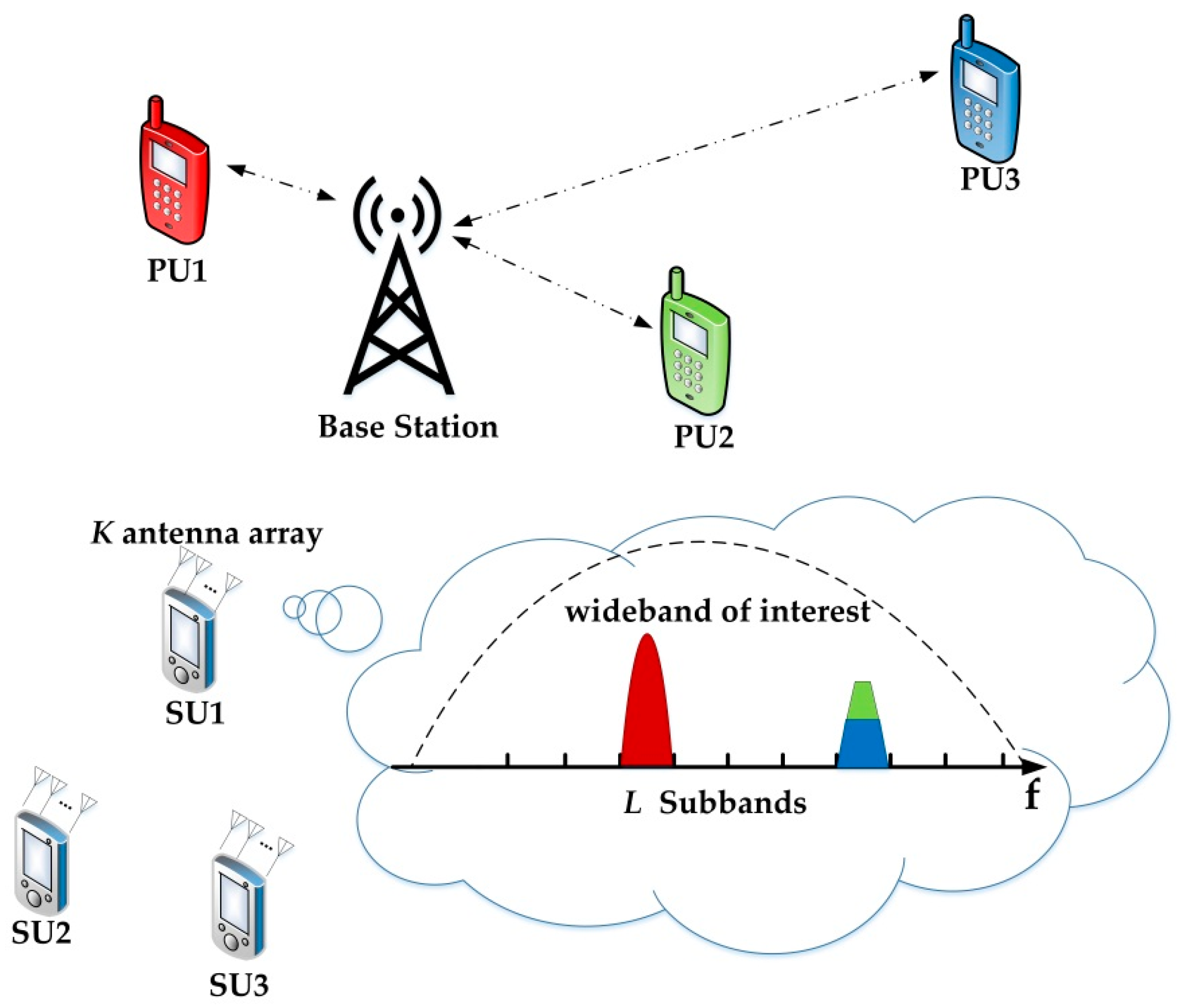

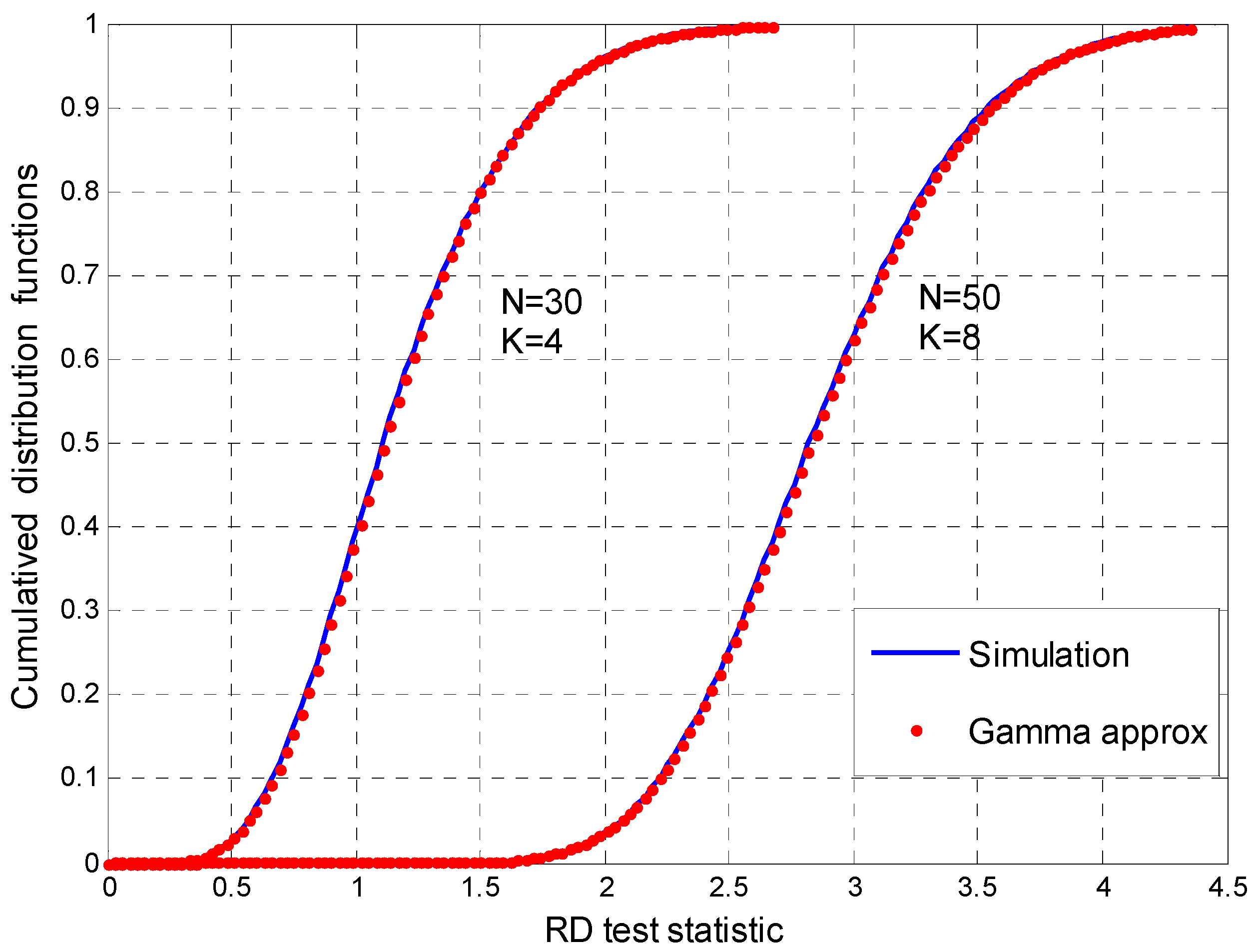
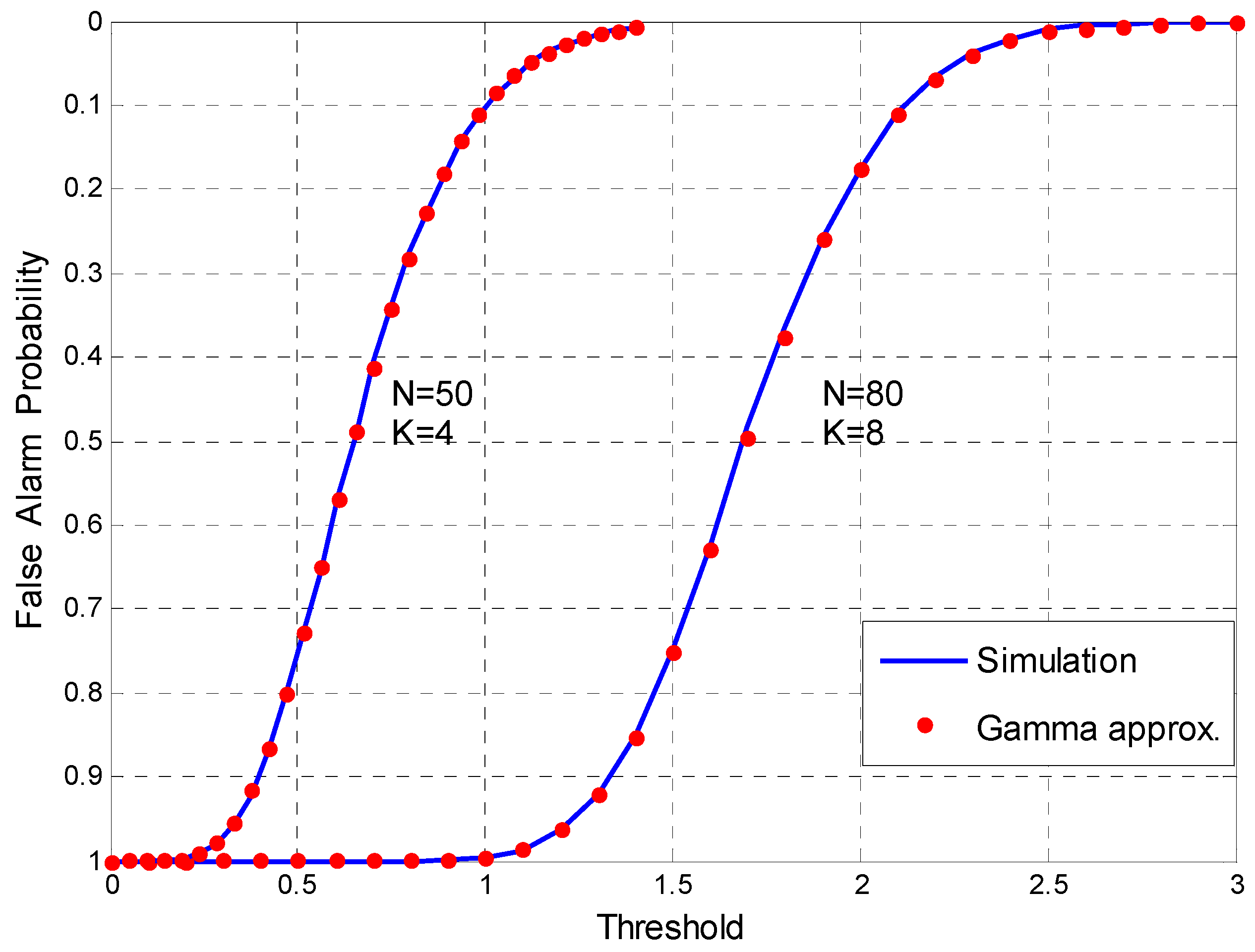
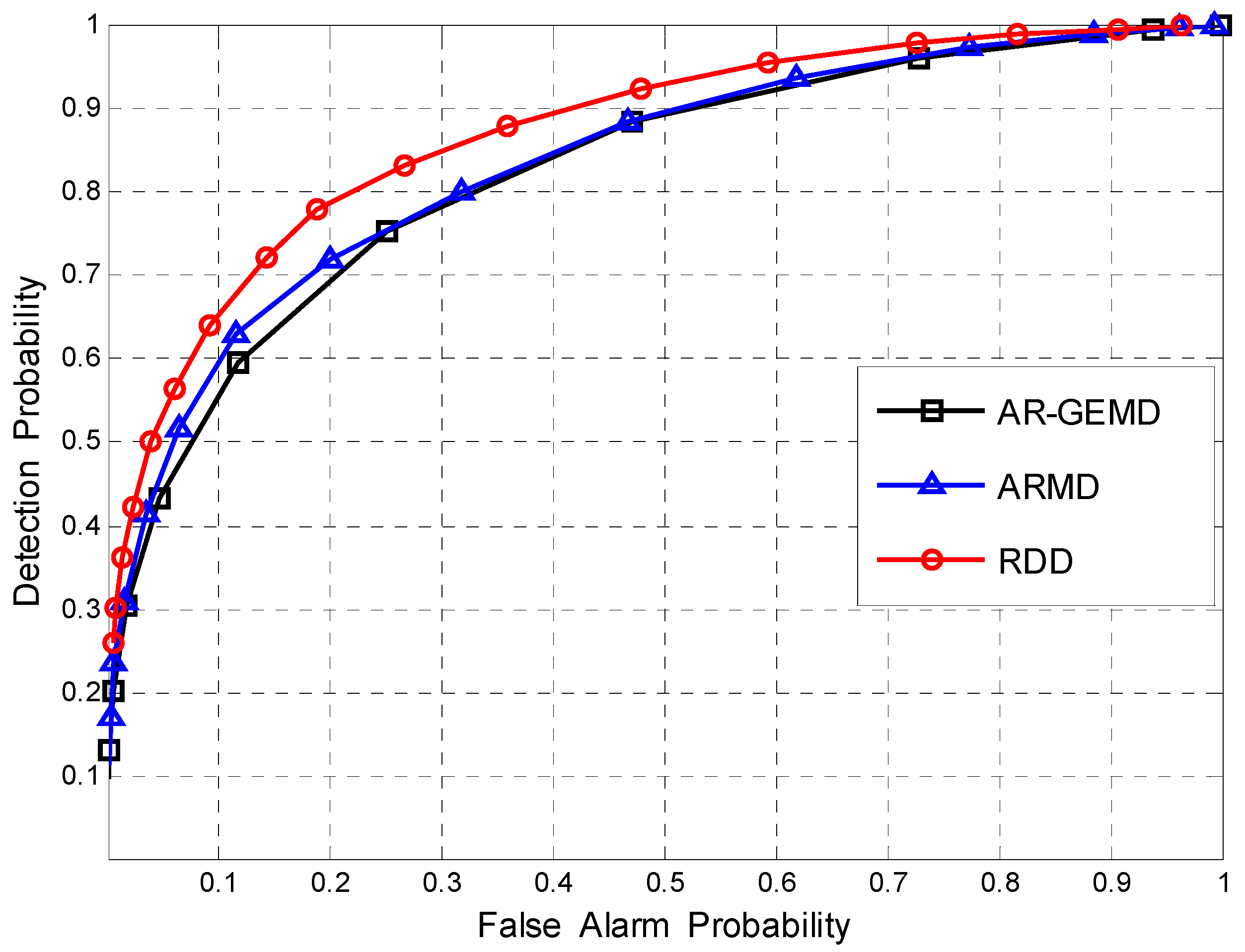


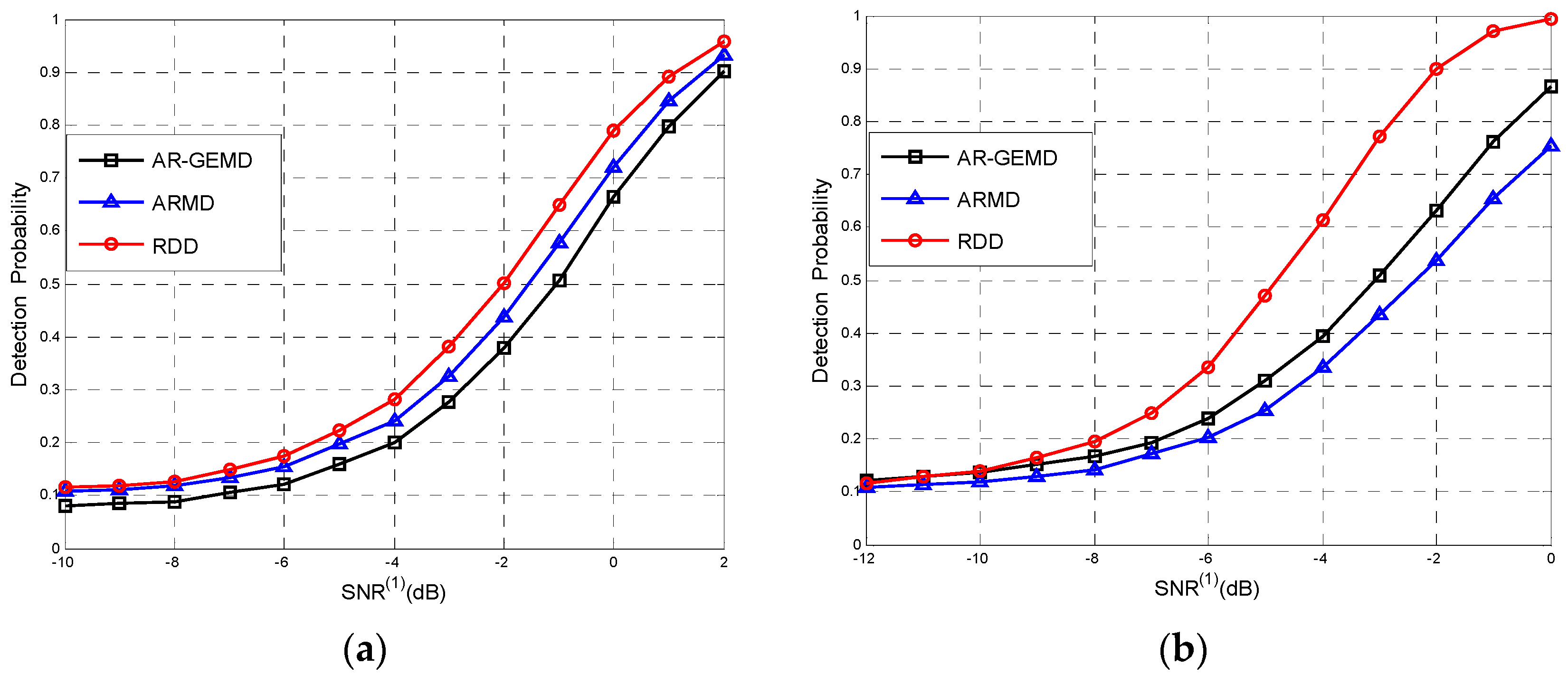
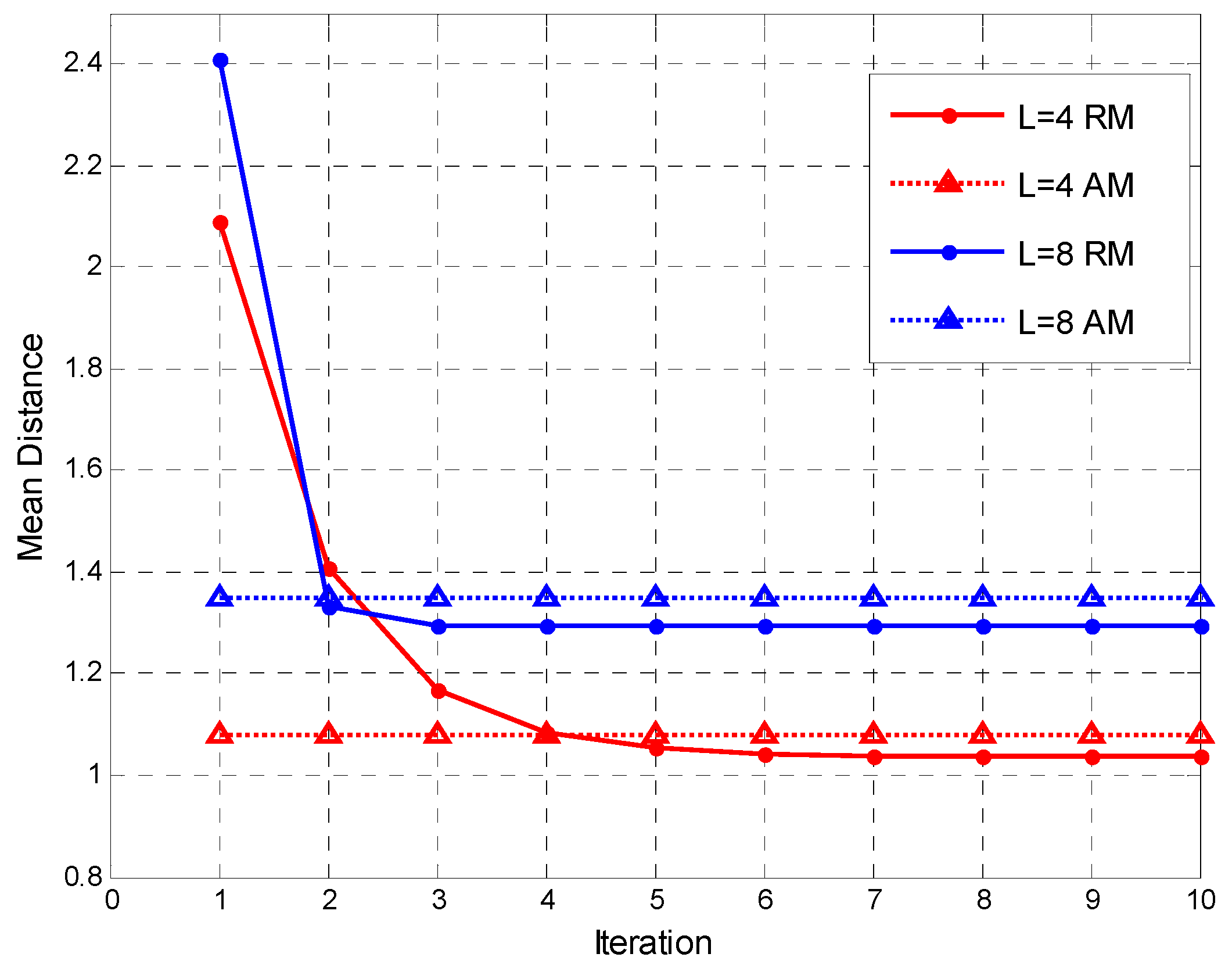
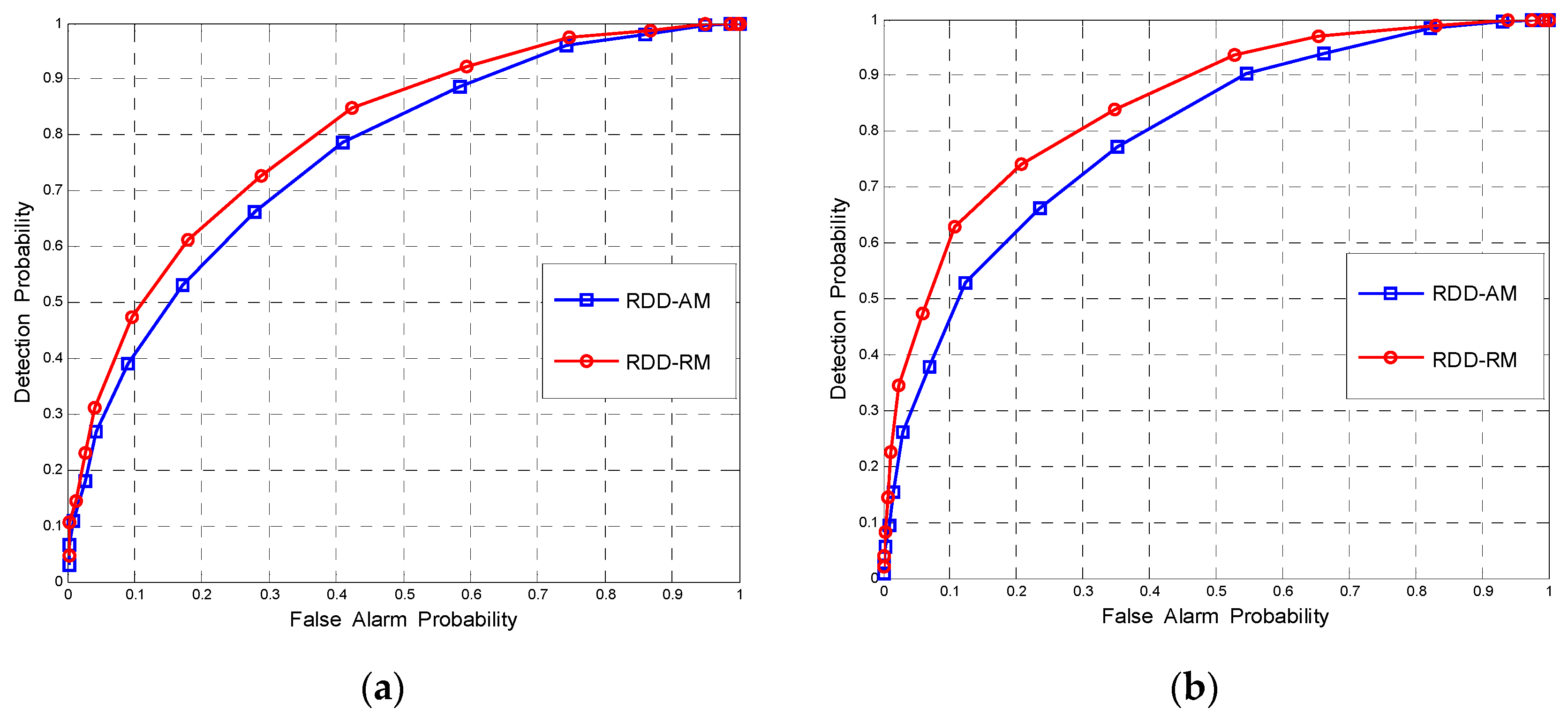
| () | (TRD) Simulated | (TRD) Analytical | Simulated | Analytical |
|---|---|---|---|---|
| 1.1708 | 1.1695 | 1.5489 | 1.5474 | |
| (50,4) | 0.6750 | 0.6756 | 0.5147 | 0.5151 |
| (50,8) | 2.8708 | 2.8667 | 8.5091 | 8.4914 |
| (80,8) | 1.7135 | 1.7424 | 3.1125 | 3.14 |
© 2017 by the authors. Licensee MDPI, Basel, Switzerland. This article is an open access article distributed under the terms and conditions of the Creative Commons Attribution (CC BY) license (http://creativecommons.org/licenses/by/4.0/).
Share and Cite
Lu, Q.; Yang, S.; Liu, F. Wideband Spectrum Sensing Based on Riemannian Distance for Cognitive Radio Networks. Sensors 2017, 17, 661. https://doi.org/10.3390/s17040661
Lu Q, Yang S, Liu F. Wideband Spectrum Sensing Based on Riemannian Distance for Cognitive Radio Networks. Sensors. 2017; 17(4):661. https://doi.org/10.3390/s17040661
Chicago/Turabian StyleLu, Qiuyuan, Shengzhi Yang, and Fan Liu. 2017. "Wideband Spectrum Sensing Based on Riemannian Distance for Cognitive Radio Networks" Sensors 17, no. 4: 661. https://doi.org/10.3390/s17040661






